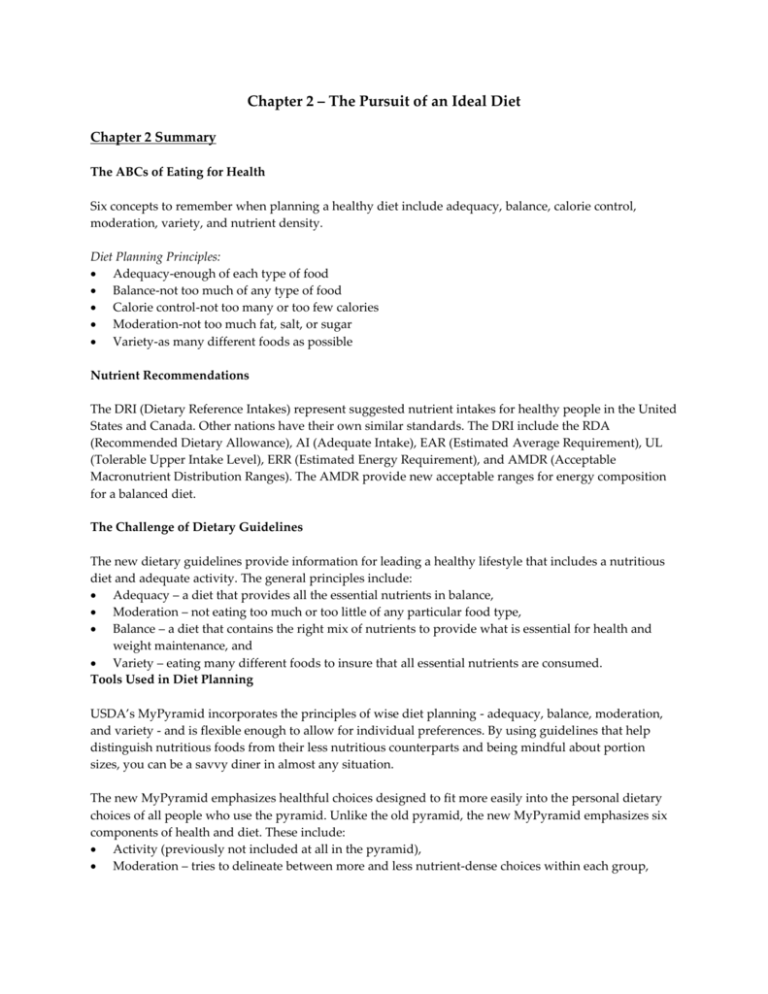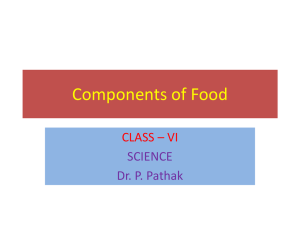Chapter 2 – The Pursuit of an Ideal Diet
advertisement

Chapter 2 – The Pursuit of an Ideal Diet Chapter 2 Summary The ABCs of Eating for Health Six concepts to remember when planning a healthy diet include adequacy, balance, calorie control, moderation, variety, and nutrient density. Diet Planning Principles: Adequacy-enough of each type of food Balance-not too much of any type of food Calorie control-not too many or too few calories Moderation-not too much fat, salt, or sugar Variety-as many different foods as possible Nutrient Recommendations The DRI (Dietary Reference Intakes) represent suggested nutrient intakes for healthy people in the United States and Canada. Other nations have their own similar standards. The DRI include the RDA (Recommended Dietary Allowance), AI (Adequate Intake), EAR (Estimated Average Requirement), UL (Tolerable Upper Intake Level), ERR (Estimated Energy Requirement), and AMDR (Acceptable Macronutrient Distribution Ranges). The AMDR provide new acceptable ranges for energy composition for a balanced diet. The Challenge of Dietary Guidelines The new dietary guidelines provide information for leading a healthy lifestyle that includes a nutritious diet and adequate activity. The general principles include: Adequacy – a diet that provides all the essential nutrients in balance, Moderation – not eating too much or too little of any particular food type, Balance – a diet that contains the right mix of nutrients to provide what is essential for health and weight maintenance, and Variety – eating many different foods to insure that all essential nutrients are consumed. Tools Used in Diet Planning USDA’s MyPyramid incorporates the principles of wise diet planning - adequacy, balance, moderation, and variety - and is flexible enough to allow for individual preferences. By using guidelines that help distinguish nutritious foods from their less nutritious counterparts and being mindful about portion sizes, you can be a savvy diner in almost any situation. The new MyPyramid emphasizes healthful choices designed to fit more easily into the personal dietary choices of all people who use the pyramid. Unlike the old pyramid, the new MyPyramid emphasizes six components of health and diet. These include: Activity (previously not included at all in the pyramid), Moderation – tries to delineate between more and less nutrient-dense choices within each group, Personalization – allows each person to figure out what choices within each group fit his/her personal tastes, Proportionality – some groups should provide more foods to the diet than others, Variety – be sure to include a variety of groups as well as a variety of choices within each group, and Gradual Improvement – provides steps to help each person make better choices to improve the diet. Food Labels The Nutrition Facts panel of food labels is another important tool you can use to eat healthfully. Food labels help you easily compare similar products. The label provides information about nutrients addressing present health concerns: calories, calories from fat, total fat, saturated fat, trans fat, cholesterol, sodium, total carbohydrate, dietary fiber, sugars, protein, vitamin A, vitamin C, calcium, and iron. Foods carrying nutrient content or health claims must meet strict rules governing the use of such claims. Exchange Lists The food exchange (originally designed for diabetics) provides a method for use in making choices within a particular good group. The list describes what a standard serving is and how many servings are contained in the food a person is choosing. The exchange list allows people to determine how many servings from a group are contained in the food they eat if it does not fit easily into an exact serving size. It is particularly useful for people who are concerned with diet adequacy and caloric content. Food Composition Tables In the rear of the book (Appendix) are several tables of food composition including amounts, calories, nutrients, and grams of carbohydrates (and fiber), fats, protein, etc. These tables enable students to calculate the calories and nutrients in the food they consume in order to help determine if their diets meet the guidelines for a nutritious diet or if the choices they are making are the most healthful. A Tapestry of Cultures and Cuisines The Spotlight feature examines some of the more prevalent food practices in mainstream America to see how they originated and how they fit into a healthful eating plan. Among these cultures and cuisines are Mexican, Chinese, Italian, African American, and Jewish American. Many nutrition experts advocate adopting aspects of the Mediterranean diet, in particular: Get daily physical activity and eat an abundance of fruits, vegetables, whole grains, and legumes combined with moderate amounts of dairy products and relatively smaller amounts of meat, poultry, and fish.










